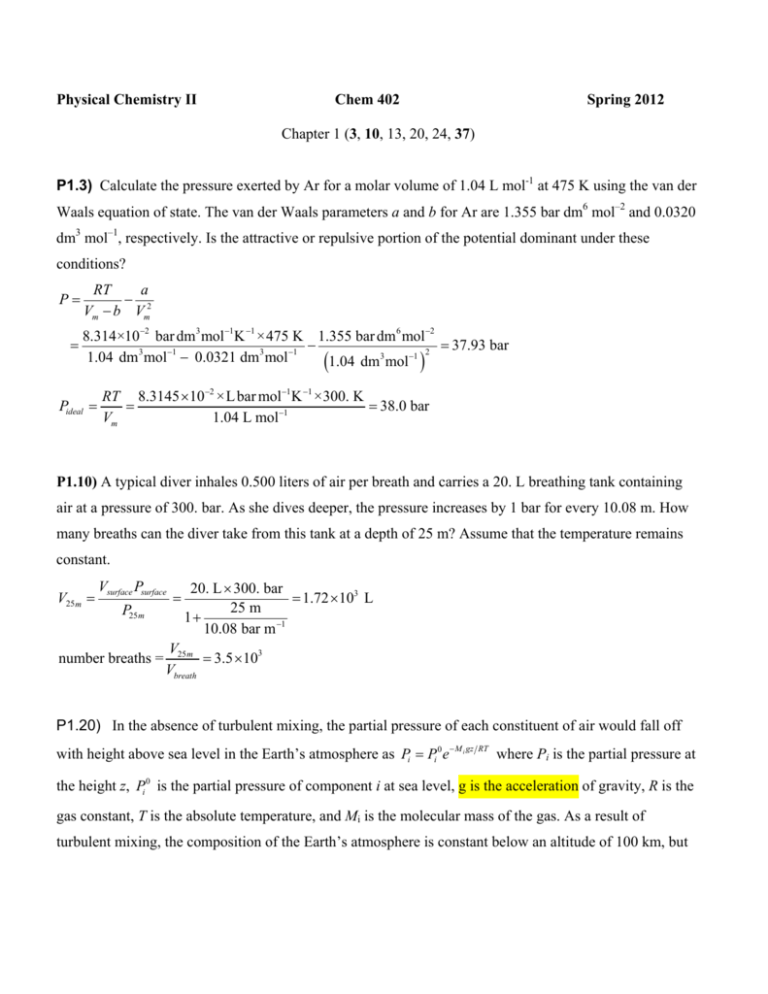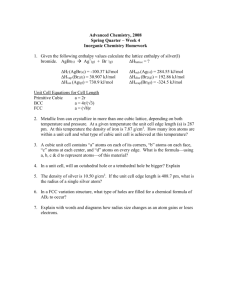P1.3) Calculate the pressure exerted by Ar for
advertisement

Physical Chemistry II Chem 402 Spring 2012 Chapter 1 (3, 10, 13, 20, 24, 37) P1.3) Calculate the pressure exerted by Ar for a molar volume of 1.04 L mol-1 at 475 K using the van der Waals equation of state. The van der Waals parameters a and b for Ar are 1.355 bar dm6 mol–2 and 0.0320 dm3 mol–1, respectively. Is the attractive or repulsive portion of the potential dominant under these conditions? P RT a 2 Vm b Vm 8.314×102 bar dm3 mol1K 1 ×475 K 1.355 bar dm 6 mol2 37.93 bar 3 1 2 1.04 dm3 mol1 0.0321 dm3 mol1 1.04 dm mol Pideal RT 8.3145 102 ×L bar mol1 K 1 ×300. K 38.0 bar Vm 1.04 L mol1 P1.10) A typical diver inhales 0.500 liters of air per breath and carries a 20. L breathing tank containing air at a pressure of 300. bar. As she dives deeper, the pressure increases by 1 bar for every 10.08 m. How many breaths can the diver take from this tank at a depth of 25 m? Assume that the temperature remains constant. V25 m Vsurface Psurface P25 m number breaths = 20. L 300. bar 1.72 103 L 25 m 1 10.08 bar m 1 V25 m 3.5 103 Vbreath P1.20) In the absence of turbulent mixing, the partial pressure of each constituent of air would fall off with height above sea level in the Earth’s atmosphere as Pi Pi 0 e M i gz RT where Pi is the partial pressure at the height z, Pi 0 is the partial pressure of component i at sea level, g is the acceleration of gravity, R is the gas constant, T is the absolute temperature, and Mi is the molecular mass of the gas. As a result of turbulent mixing, the composition of the Earth’s atmosphere is constant below an altitude of 100 km, but the total pressure decreases with altitude as air. At sea level, P P0eMave gz RT xN 2 0.78084 and xHe 0.00000524 where Mave is the mean molecular weight of and T = 300 K. a) Calculate the total pressure at 10.0 km assuming a mean molecular mass of 28.9 g mol-1 and that T = 300 K throughout this altitude range b) Calculate the value that xN 2 xHe would have at 10.0 km in the absence of turbulent mixing. Compare your answer with the correct value. Ptot PN02 e M i gz RT 28.9 103 kg 9.81 m s 2 10.0 103 m 1.0125 105 Pa exp 8.314 J mol1 K 1 300. K 3.25 104 Pa PN2 P e 0 N2 M i gz RT 28.02 103 kg 9.81 m s 2 10.0 103 m 0.78084 1.0125 105 Pa exp 8.314 J mol1 K 1 300. K 4 2.63 10 Pa PHe PHe0 e M i gz RT 4.003 103 kg 9.81 m s 2 10.0 103 m 5.24 10 1.0125 10 Pa exp 8.314 J mol1 K 1 300. K 0.453 Pa 6 PN2 PHe PN2 PHe 5 5.79 104 without mixing xN 2 xHe 0.78084 1.49 105 with mixing 6 5.24 10 P1.24) When Julius Caesar expired, his last exhalation had a volume of 500. cm3 and contained 1.00 mole percent argon. Assume that T = 300. K and P = 1.00 atm at the location of his demise. Assume further that T has the same value throughout the Earth’s atmosphere. If all of his exhaled Ar atoms are now uniformly distributed throughout the atmosphere, how many inhalations of 500. cm3 must we make to inhale one of the Ar atoms exhaled in Caesar’s last breath? Assume the radius of the Earth to be 6.37 × 106 m. [Hint: Calculate the number of Ar atoms in the atmosphere in the simplified geometry of a plane of area equal to that of the Earth’s surface. See Problem 1.20 for the dependence of the barometric pressure on the height above the Earth’s surface.] is the number of Ar atoms The total number of Ar atoms in the atmosphere is N Ar N Ar Adz where N Ar 0 per m3 at the surface of the earth. N Ar is given by N P 6.023 1023 0.0100 1 105 Pa N Ar A Ar 2.411023 m 3 RT 8.314 J K 1 mol1 300 K The total number of Ar atoms in the atmosphere is N Ar 0 0 N Ar Adz N Ar e M Ar gz RT RT Adz N Ar A M Ar g 2.411023 m 3 4 6.37 106 m 8.314 J mol 1 K 1 300 K 2 39.9 103 kg 9.81 m s 2 7.85 1041 The fraction of these atoms that came from Caesar’s last breath, f, is given by f N Ar V 2.411023 m 3 0.500 103 m3 1.53 1022 7.85 1041 N Ar The number of Ar atoms that we inhale with each breath is N NA PV 102 1 105 Pa 0.500 103 m3 6.023 1023 mol1 1.211020 1 1 RT 8.314 J mol K 300 K The number of these that came from Caesar’s last breath is fN fN 1.53 1022 1.211020 1.85 102 The reciprocal of this result, or 54, is the number of breaths needed to inhale one Ar atom that Caesar exhaled in his last breath. df x dx P1.37) Use L’Hôpital’s rule, lim f x g x x 0 lim to show that the expression dg x dx x 0 derived for Pf in part b of Example Problem 1.1 has the correct limit as → 0. Pf Vi 1 Pf Pi PV i i ; Ti Tf PT i f Pf Ti 1 Pf Pi Pf2Ti Pf Ti 1 Pi PT i f 0 Ti 1 Pi Ti 2 1 Pi 4TT i f Pi 2 Pf 2Ti 2 i f Pi df d d Ti 1 Pi Ti 1 Pi 4TT lim 0 dg d d 2Ti d Ti Pi lim 2Ti 2 1 Pi Pi 4TT i fP 2 Ti 2 1 Pi 4TT i f Pi Ti Pi PT i i 2i T f Pi 2Ti Ti Pi 2 2Ti 0 2 Tf P Ti d 2Ti 2 Pi 4TT i fP 2Ti 2Ti








